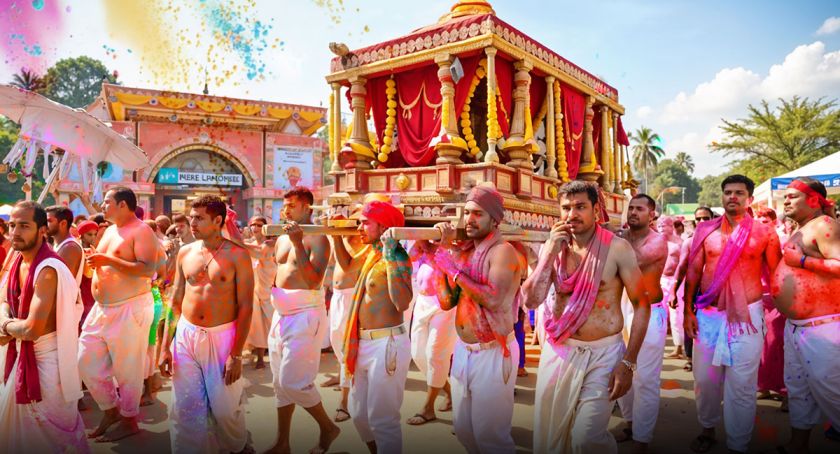Dola Purnima: Odisha’s Grand Festival of Colors, Devotion, and Joy
As spring tiptoes into Odisha, painting the land with blooming flowers and golden sunshine, the air hums with the rhythm of cymbals, conch shells, and joyous laughter. The streets become a carnival of colors, music, and devotion. It’s that magical time of the year when Odisha celebrates Dola Purnima, a festival that blends faith, festivity, and folklore into a mesmerizing spectacle.
This grand celebration, often called “the Holi of Odisha,” is more than just playing with colors. It is an ancient tradition dedicated to Lord Krishna, revered as Dolagovinda, where devotees sing, dance, and carry their beloved deity on a beautifully decorated palanquin (Dola Bimana) through the streets. The festival, deeply rooted in Vaishnavism, marks the arrival of spring, symbolizing renewal, love, and divine blessings.
The Divine Prelude: Legends Behind Dola Purnima
Every festival in Odisha carries a story, and Dola Purnima is no exception. According to Hindu mythology, this festival celebrates the playful and divine love of Lord Krishna and Radha. The legend goes that Krishna, the mischievous yet compassionate deity, loved smearing colors on Radha and the Gopis in Vrindavan. This playful act of Krishna evolved into the festival of Dola Jatra, which later became associated with Holi.
Another belief connects Dola Purnima to the full moon night of Phalguna (February-March) when Krishna ascended the swing (Dola) and blessed his devotees. Every year in Odisha, devotees recreate this act of devotion and joy by carrying Krishna idols in palanquins, worshipping them, and parading them with grandeur.
A Festival of Devotion: The Grand Rituals
Dola Purnima is not just about colors; it is a sacred journey of faith and celebration. The festival unfolds over five days, each filled with rituals, music, and festivity.
Day 1: Gundicha Utsav – Welcoming the Lord
The devotees ceremoniously bring the idols of Radha and Krishna from temples to a specially prepared altar during Gundicha Utsav. Devotees offer Bhoga (sacred food), flowers, and sandalwood paste, marking the beginning of the Dola Jatra.
Day 2-4: Swinging into Devotion
Krishna idols, adorned in resplendent attire and jewelry for the next few days, are placed on a decorated swing (Dola Peetha). Devotees gather to perform aartis (prayers), sing devotional songs, and recite hymns from the Bhagavad Gita. Temples resonate with the beats of mridangam (a percussion instrument), and devotees dance in divine ecstasy.
Day 5: The Grand Dola Jatra – A Parade of Faith
The festival’s climax is the Dola Jatra, a grand procession where Krishna’s idol is placed on a gorgeously adorned palanquin and carried through the village or town. Accompanied by a procession of musicians, priests, and devotees, the streets transform into a river of devotion and joy. People shower colors, offer fruits and sweets, and seek blessings from the Lord.
The swinging of the idol symbolizes Krishna’s presence among his devotees, showering them with divine love and happiness. Holi celebrations begin as the full moon rises, marking the final night, and the festival concludes with a riot of colors, laughter, and togetherness.
Beyond Devotion: The Cultural Extravaganza
Dola Purnima is a cultural spectacle that brings communities together.
- Folk Performances: Villages come alive with Pala, Daskathia, and Odissi dance performances, narrating the tales of Krishna’s divine exploits.
- Rangoli and Pattachitra Art: Homes and temples are adorned with intricate rangoli patterns and Pattachitra paintings, depicting the festival’s grandeur.
- Feast Fit for a God: No Odia festival is complete without sumptuous food! Devotees prepare Malpua, Khira, Chhena Poda, and Dalma to offer to the Lord, and then they relish these dishes as Mahaprasad.
- Music and Joy: Villagers gather in groups, singing Bhajans and Sankirtans, filling the air with devotion and happiness.
The vibrance of Dola Purnima: A Festival That Unites
While Dola Purnima is deeply rooted in religious beliefs, it also serves as a social festival that unites people beyond caste, creed, and status.
- It strengthens community bonds as people come together in devotion and celebration.
- It fosters cultural heritage, preserving Odisha’s rich traditions for future generations.
- It promotes joy and harmony, reminding everyone of the beauty of togetherness and love.
In today’s fast-paced and disconnected world, festivals like Dola Purnima ignite the spirit of unity, faith, and celebration. It is a festival where the divine meets the mortal, the sacred meets the playful, and tradition meets the festivity.
Final Thoughts: Charm of Dola Purnima
As the moon shines bright on the night of Dola Purnima, joy, devotion, and gratitude fill hearts. The streets echo with the drum beats, the chants of Krishna’s name, and the laughter of people smeared in colors. The festival paints faith in vibrant hues, and devotion flows like a river of happiness.
So, if you ever find yourself in Odisha during this time, soak yourself in the magic of Dola Purnima. Witness the divine procession, sing along with the devotees, play with colors, and experience the warmth of Odisha’s rich culture. Because Dola Purnima is not just a festival; it is an experience, a feeling, and a celebration of life itself!
Jai Jagannath! Jai Dolagovinda!


